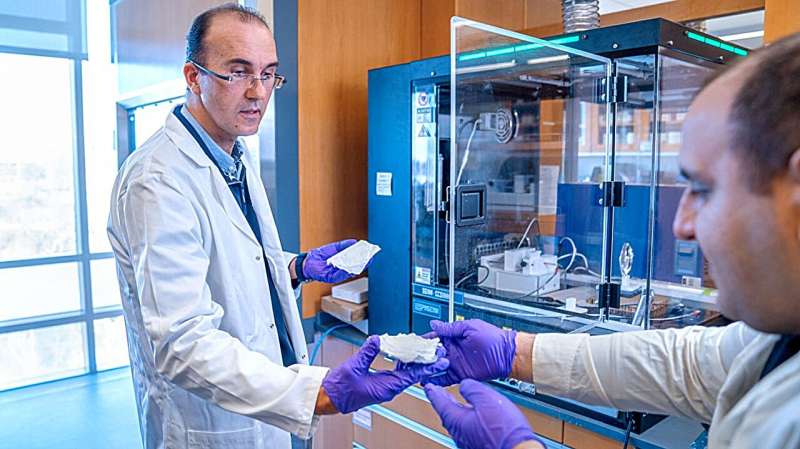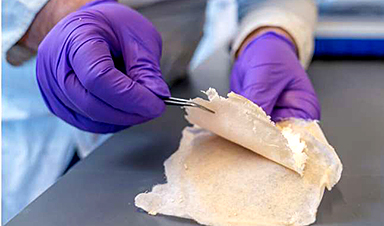An interdisciplinary team of Cornell researchers has identified an innovative way to harness the antioxidant and antibacterial properties of the botanical compound lawsone to make nanofiber-coated cotton bandages that fight infection and help wounds heal more quickly.
Their findings, published in the International Journal of Pharmaceutics, are especially important given the increasing prevalence of multidrug-resistant bacteria.
Cotton gauze is one of the most common wound dressings; it’s inexpensive, readily available, comfortable and biocompatible. However, it doesn’t promote healing or fight infection.
“Cotton alone cannot provide an answer for these complications—it needs to be biofunctionalized,” said lead author Mohsen Alishahi, a doctoral student in fiber science who works in the NanoFibers and NanoTextiles (NanoFibTex) Laboratory in the College of Human Ecology’s Department of Human Centered Design (HCD).
Tamer Uyar, associate professor in HCD and the lab’s director, said one of its main research interests is developing functional fibers from sustainable materials and exploring their potential applications in medical textiles and drug delivery systems.
For this work, Alishahi, Uyar and doctoral student Mahmoud Aboelkheir used lawsone, a red-orange compound found in henna leaves that has antioxidant, anti-inflammatory and antimicrobial properties, to boost the performance of cotton.

on developing nanofiber-coated cotton bandages. Credit: Darcy Rose/Cornell University
Lawsone has been shown to help wounds heal more quickly, but it’s difficult to dissolve in a solution and not readily absorbed by the body. To overcome these limitations, the team used cyclodextrins, a family of natural oligosaccharides produced from starch, to create an inclusion compound, binding the lawsone molecules within the cyclodextrin.
They then used electrospinning equipment to produce a uniform nanofibrous coating from the lawsone-cyclodextrin solution, capturing it on a nonwoven cotton pad. They found that the experimental dressing had significantly higher antioxidant activity—promising faster wound healing—compared with pure lawsone, thanks to the increased solubility of the lawsone by cyclodextrin inclusion, and the high surface-to-volume ratio of the nanofibrous system.
The NanoFibTex team then worked with Craig Altier, professor of population medicine and diagnostic sciences, and Rimi Chowdhury, senior research associate, both in the College of Veterinary Medicine, to test the dressing’s biological properties. The experimental dressing had excellent antibacterial performance against gram-negative and gram-positive bacterial species, and effectively eradicated E. coli and staph bacteria in testing.
“The prolonged overuse of synthetic antibiotics in high concentrations has contributed to the rise of the deadly epidemic of multidrug-resistant microbes,” Uyar said. “So the use of natural and potent anti-bacterials such as lawsone may serve as an alternative to synthetic anti-bacterials.”
“Wound dressings should provide a suitable environment for facilitating healing and preventing infection,” Alishahi said. “Using totally natural materials such as cotton, cyclodextrin and lawsone, this dressing can facilitate both as it has comprehensive antioxidant and anti-bacterial activity.”
Alishahi said that the dressing would be particularly helpful for chronic wounds that are highly susceptible to infection, like diabetic ulcers and burns. The antioxidant and anti-inflammatory properties would also benefit more routine wounds by reducing the formation of scars.
“I am familiar with the complications patients face due to the lack of suitable dressings,” said Alishahi, who formerly worked in a burn- and wound-healing research center. “My ultimate goal is to develop a dressing that can overcome these difficulties for them. This work opens doors to creating medical textiles that are good for the environment and great for healing.”
More information: Mohsen Alishahi et al, Functionalization of cotton nonwoven with cyclodextrin/lawsone inclusion complex nanofibrous coating for antibacterial wound dressing, International Journal of Pharmaceutics (2024). DOI: 10.1016/j.ijpharm.2024.123815
Provided by Cornell University
News
Scientists Unlock a New Way to Hear the Brain’s Hidden Language
Scientists can finally hear the brain’s quietest messages—unlocking the hidden code behind how neurons think, decide, and remember. Scientists have created a new protein that can capture the incoming chemical signals received by brain [...]
Does being infected or vaccinated first influence COVID-19 immunity?
A new study analyzing the immune response to COVID-19 in a Catalan cohort of health workers sheds light on an important question: does it matter whether a person was first infected or first vaccinated? [...]
We May Never Know if AI Is Conscious, Says Cambridge Philosopher
As claims about conscious AI grow louder, a Cambridge philosopher argues that we lack the evidence to know whether machines can truly be conscious, let alone morally significant. A philosopher at the University of [...]
AI Helped Scientists Stop a Virus With One Tiny Change
Using AI, researchers identified one tiny molecular interaction that viruses need to infect cells. Disrupting it stopped the virus before infection could begin. Washington State University scientists have uncovered a method to interfere with a key [...]
Deadly Hospital Fungus May Finally Have a Weakness
A deadly, drug-resistant hospital fungus may finally have a weakness—and scientists think they’ve found it. Researchers have identified a genetic process that could open the door to new treatments for a dangerous fungal infection [...]
Fever-Proof Bird Flu Variant Could Fuel the Next Pandemic
Bird flu viruses present a significant risk to humans because they can continue replicating at temperatures higher than a typical fever. Fever is one of the body’s main tools for slowing or stopping viral [...]
What could the future of nanoscience look like?
Society has a lot to thank for nanoscience. From improved health monitoring to reducing the size of electronics, scientists’ ability to delve deeper and better understand chemistry at the nanoscale has opened up numerous [...]
Scientists Melt Cancer’s Hidden “Power Hubs” and Stop Tumor Growth
Researchers discovered that in a rare kidney cancer, RNA builds droplet-like hubs that act as growth control centers inside tumor cells. By engineering a molecular switch to dissolve these hubs, they were able to halt cancer [...]
Platelet-inspired nanoparticles could improve treatment of inflammatory diseases
Scientists have developed platelet-inspired nanoparticles that deliver anti-inflammatory drugs directly to brain-computer interface implants, doubling their effectiveness. Scientists have found a way to improve the performance of brain-computer interface (BCI) electrodes by delivering anti-inflammatory drugs directly [...]
After 150 years, a new chapter in cancer therapy is finally beginning
For decades, researchers have been looking for ways to destroy cancer cells in a targeted manner without further weakening the body. But for many patients whose immune system is severely impaired by chemotherapy or radiation, [...]
Older chemical libraries show promise for fighting resistant strains of COVID-19 virus
SARS‑CoV‑2, the virus that causes COVID-19, continues to mutate, with some newer strains becoming less responsive to current antiviral treatments like Paxlovid. Now, University of California San Diego scientists and an international team of [...]
Lower doses of immunotherapy for skin cancer give better results, study suggests
According to a new study, lower doses of approved immunotherapy for malignant melanoma can give better results against tumors, while reducing side effects. This is reported by researchers at Karolinska Institutet in the Journal of the National [...]
Researchers highlight five pathways through which microplastics can harm the brain
Microplastics could be fueling neurodegenerative diseases like Alzheimer's and Parkinson's, with a new study highlighting five ways microplastics can trigger inflammation and damage in the brain. More than 57 million people live with dementia, [...]
Tiny Metal Nanodots Obliterate Cancer Cells While Largely Sparing Healthy Tissue
Scientists have developed tiny metal-oxide particles that push cancer cells past their stress limits while sparing healthy tissue. An international team led by RMIT University has developed tiny particles called nanodots, crafted from a metallic compound, [...]
Gold Nanoclusters Could Supercharge Quantum Computers
Researchers found that gold “super atoms” can behave like the atoms in top-tier quantum systems—only far easier to scale. These tiny clusters can be customized at the molecular level, offering a powerful, tunable foundation [...]
A single shot of HPV vaccine may be enough to fight cervical cancer, study finds
WASHINGTON -- A single HPV vaccination appears just as effective as two doses at preventing the viral infection that causes cervical cancer, researchers reported Wednesday. HPV, or human papillomavirus, is very common and spread [...]





















